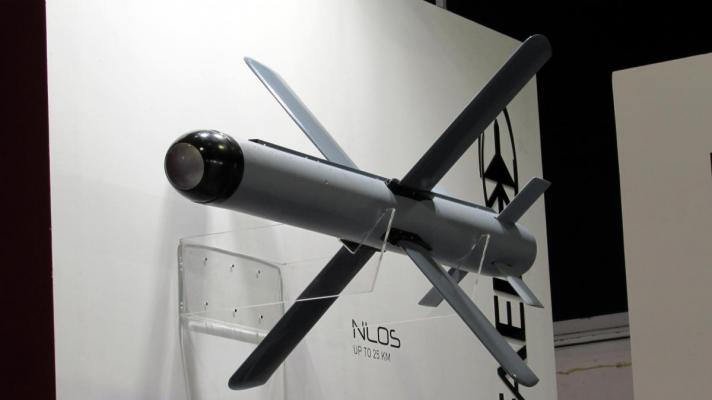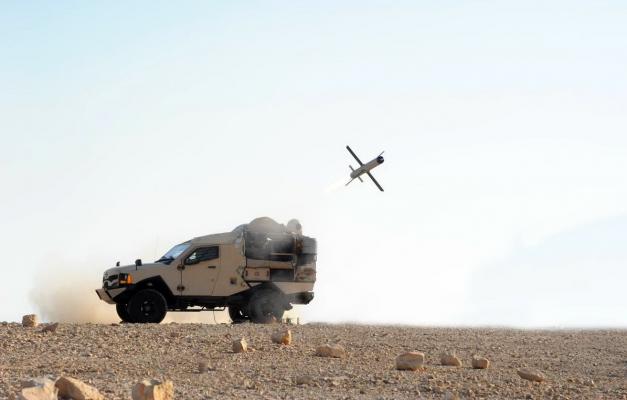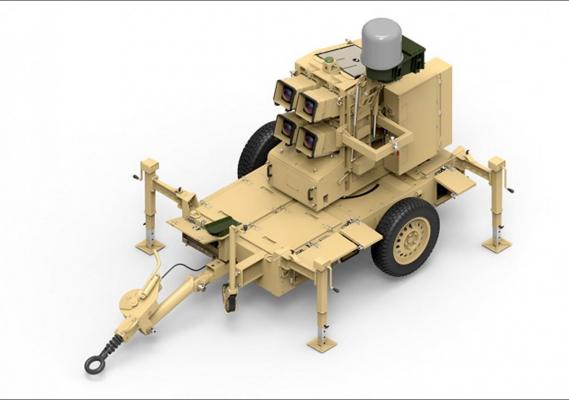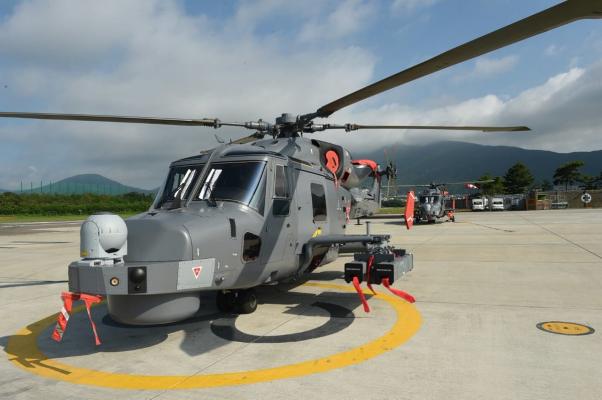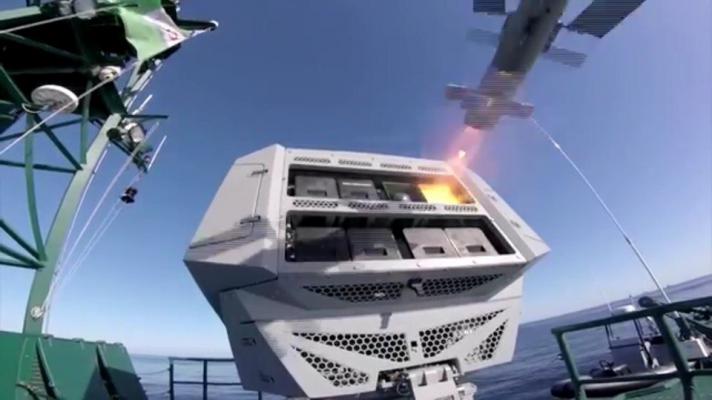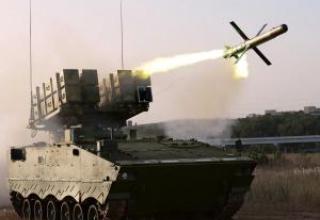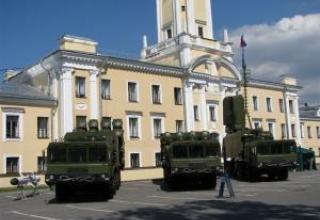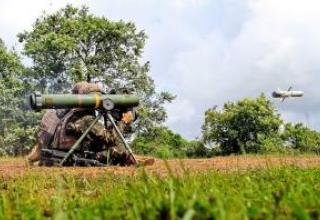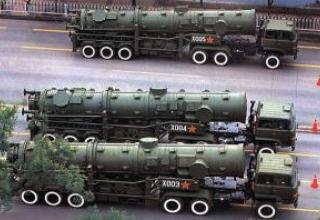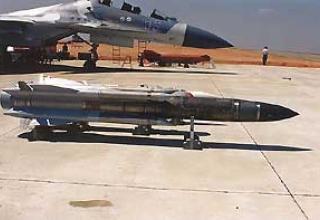Multi-purpose long-range missile system Spike-NLOS (Non-Line Of Sight) is designed to destroy modern armored vehicles, including those equipped with dynamic protection, fortifications and engineering structures, enemy manpower, low-speed surface targets outside the line of sight, at any time of day, in difficult weather conditions at ranges up to 25 km.
Spike-NLOS is used to arm attack helicopters, surface ships and accommodation on self-propelled and towed chassis of various types.
The development of Spike-NLOS (Tamuz -תמוז) rocket started in the late seventies, in 1981 it was adopted by the Israel Defense Forces.
The complex is a part of the Israeli Rafael APC family, which, in addition to Spike-NLOS, includes: light portable Spike-SR with a range up to 1500m, Spike-MR with a range up to 2500m, Spike-LR with a range up to 4000m, Spike-ER with a range up to 8km.
Spike NLOS was first used by the Israel Defense Forces in combat conditions in 2006 during the Second Lebanon War to fight Hizbullah formations. About 600 missiles were used, and no data on combat effectiveness was published. Several dozen missiles were used during Operation Cast Lead in the Gaza Strip.
Spike-NLOS was first presented at an arms exhibition in Singapore in late 2009.
Composition:
The Spike NLOS rocket is designed according to the normal aerodynamic scheme and has a large elongation cylindrical body with a hemispherical head cowl. The middle part of the hull has X-shaped wings, and the tail part has one-piece steering wheels of the same configuration (see photo1©Tomasz Szulc, photo2). To reduce the size of the missile in the transport position, the wings and rudders are folded. The fenders are folded along the hull by turning forward around the hinge at the front edge and open after leaving the TIC.
The combat unit of Spike NLOS missiles of the early Mk2 and Mk4 modifications is a tandem cumulative warhead. Depending on the combat mission, the Mk5 missile can use a tandem cumulative warhead or a fragmentation-phase warhead. The missile can be equipped with a PBF (Penetration, Blast and Fragmentation) high-explosive warhead to engage fortifications and buildings,
The control system of Mk2 modification missiles - combined, includes: a television homing head, an inertial system and a semi-automatic command guidance system. The Mk4 missile control system includes: an uncooled dual-channel IIR thermal/television homing head, inertial system, satellite positioning system and two-way radio data transmission equipment providing automatic command guidance mode. In the latter case, a video system is used that transmits the image to the operator's console. This makes it possible to implement a wide range of combat applications, including shot-and-forget, target acquisition and redirection after launch, command guidance and implementation of complex flight trajectories, shooting at an invisible target from a closed position, real-time intelligence acquisition, target identification and engagement in the most vulnerable parts. It has been reported that the Mk5 modification rocket can also be equipped with a laser semi-active homing head.
The Spike NLOS missile system can use third party target designation to attack targets beyond line of sight. Intelligence units, unmanned aerial vehicles, etc. can transmit target location information to the operator's console using operational control, command, data collection, surveillance and intelligence (C4I) systems, allowing digital information to be shared.
The disadvantages of the Spike-NLOS complex include: low missile flight speed (about 190 m/sec), insufficient reliability of target acquisition in the conditions of fog, poor visibility and aerosol interference used by the enemy.
Placement options on self-propelled landing gear and trailers
Spike-NLOS can be placed on self-propelled chassis of various types, including lightweight. In the original version of the missile system, which includes: a four-container guided in the horizontal plane launcher, electronic-optical fire detection and control system Rafael Toplite, remote control and radio command line equipment, was located on the basis of military vehicles HMMWV American production.
At Eurosatory-2010 was presented a version of the complex on the chassis of the armored car M-ATV with 4x4 wheel configuration of the American company Oshkosh Truck (engine power - 370 hp, speed on the highway - 105 km/h, range of 515 km). In this version, the complex includes a launcher with four missiles in transport and launch containers (TPK), a rack for ammunition consisting of six missiles in the TPK, fire detection and control system, radio equipment. The complex is controlled from the operator's console in the cabin (see photo). The stationary launcher is placed in the body across the longitudinal axis of the vehicle.
Later, a similar version of Spike-NLOS was implemented on the basis of the Sand Cat of the Israeli company Plasan (see photo1, photo2). The Sand Cat is made on a shortened chassis Ford F550, equipped with a 6.4-liter V8 engine with a capacity of 325 hp and a speed up to 160 km/h. Series production of the vehicle was launched in the summer of 2009.
Under the contract of 2011, 67 copies of the complex on Sand Cat chassis were purchased by South Korea (see photo1, photo2, photo3).
At Eurosatory-2016, Rafael Advanced Defence Systems presented new versions of the complex on the chassis of the Polaris MRZR 4 buggy. One variant is a launcher (PU) with two PPKs and an ammunition rack for four containers, the other is a four-container PU with two spare ammunition (see photo). The first sample weighs 700 kg and the second one 900 kg. The calculation of the complex - 2 numbers. Polaris MRZR 4 can be transported in the cargo bay of CH-47 Chinook helicopter.
Missiles Spike-NLOS (Tamuz) is equipped with a self-propelled launcher Pereh. The launcher (see photo1, photo2, photo3, photo4) is mounted on the chassis of the M48A5 tank and is equipped with 12 container launchers, which are installed at the rear of the turret. When firing, the launcher lifts upwards. The design feature of the Pereh launcher is that it is camouflaged under Israel's Merkava main battle tank. For this purpose, the combat vehicle is fitted with special light camouflage elements, including a tank gun simulator.
In April 2007, 14 American M113 tracked armoured personnel carriers with Spike-NLOS launchers were purchased from Israel for the British contingent operating in Iraq (see image 1, image 2), which under the designation of Yehastog Mk1 have been used by British artillery in Basra since August 2007. They were supplemented by 600-700 Spike-NLOS Mk2 and Mk4 missiles from the Israeli army. At the same time, the fire characteristics of the complex, based on combat experience, were highly appreciated.
In September 2009, all systems Ehastog Mk1 were transferred by military transport aircraft C-130 from Basra to the British contingent in Afghanistan, where they became part of the battery MLRS MLRS (GMLRS) of the 39th Regiment of Royal Artillery, located at Forward Base "Edinburgh" in Helmand province.
At the same time, the British Army ordered the Rafael new Mk5 missiles. Deliveries of the Mk5 were apparently started in 2011, the cost per missile is called 100 thousand dollars. Due to the inexpediency of continuing to use the non-standard British base APC M113, in 2012, the British Army ordered Rafael to develop a light towed launcher Spike-NLOS complex in June 2012. The sub-contractors are Thales UK and Frazer Nash.
A prototype of the new system, designated Ehastog Mk2, was presented in March 2013, and formally adopted in August 2013, even before the tests were completed. Delivery of the Ejastog Mk2 to the British Army is reported to have started in 2014. The unit includes a four-container trailer mounted on a single-axle trailer, the Rafael Toplite electronic fire detection and control system and radioline guidance equipment. The guidance operator's station (see photo1) can be placed at a distance of up to 500m from the launcher.
At the International Defence Industry Fair MSPO 2017 in Poland the new ROSOMAK 6X6 anti-tank complex was presented (see photo1, photo2, photo3). The vehicle is equipped with a new remote-controlled turret armed with four Spike NLOS launchers.
Air-based variants
Spike-NLOS can be placed on virtually any helicopter, including light helicopters. One of the first options adopted by the Israel Defense Forces was the Bell AN-1 Cobra platform (see photo1, photo2).
The complex is part of the armament of deck-based helicopters AW-159 Wildcat of the South Korean Navy.
In 2016, the Philippine Department of Defense signed a contract with AugustaWestland for the supply in 2018 of AW-159 helicopters armed with the Spike-NLOS complex. The helicopters are planned to be deployed on board two frigates of the Philippine Navy ordered from South Korea and to be used to defeat surface targets.
The air-based Spike-NLOS frigates are part of the Spike-NLOS:
- Spike-NLOS guided missiles in transport and launch containers;
- launchers equipped with standard suspension units;
- Top Lite sighting and search system.
Rockets are placed on the helicopter in two paired launchers, which are attached to standard suspension units on the fuselage. Electrono-optical all-day Top Lite system (standard information exchange MIL STD 1553) includes an infrared camera, a television camera based on CCD-Charge Coupled Device and a laser rangefinder.
A variant of the launcher has been developed on which, in addition to Spike-NLOS missiles, Spike-ER PTUR can be used (see photo).
Shipboard variants
Various versions of ship complexes with Spike-NLOS missiles are used to equip surface ships, including small displacement.
Azerbaijan's OPV 62 (Saar 62) project border ships, developed by Israel Shipyards, are equipped with an eight-charge Typhoon MLS NLOS launcher (see photo1, photo2). The ship has a total stock of 20 Spike NLOS missiles. Radio electronic equipment includes a combined IAI Elta SGRS EL/M-2228X fire detection and control radar and a Rafael Toplite fire detection and control system.
At the Euronaval-2016 international exhibition in Le Bourget, Rafael presented one of the variants of the Typhoon MLS lightweight turret unit designed for positioning, pointing and remote automated launch of Spike-NLOS missile and two Spike-ER missiles (see photo).
Characteristics:
| Range of fire, m | 25000 |
| Weight of the rocket in the TPC, kg | 71 |
| Weight BC, kg | 6 |
| Dimensions, mm: - length - diameter - wingspan |
1670 170 1200 |
| Flight speed, m/s: | 130 - 180 |
| Temperature range: - applications - repositories |
between -32 and 49°C between -45 and 71°C |
Testing:
05.09.2008 The US Navy conducted the second test of SM-6 surface-to-air missiles with over-the-horizon guidance. The missile intercepted a BQM-74 air target.
01.09.2012 In the course of the test, SM-6 was used to destroy a cruise missile target and receive designation from the JLENS system.
01.03.2013 Raytheon delivered the first SM-6 to the U.S. Navy, assembled at its new assembly and test facility in Huntsville, Alabama.
14.06.2013 The Republic of Korea has decided to begin equipping its Aegis destroyers with SM-6 anti-aircraft missiles from 2016. The decision was adopted within the South Korean government's programme on the creation of a national air and missile defence system (KAMD).
26.08.2013 The U.S. Navy fired two SM-6 anti-aircraft missiles from the USS CG-52 Chancellorsville (Ticonderoga class), which successfully intercepted two BQM-74 air targets that simulated cruise missiles.
18-20.06.2014 The USS DDG-23 John Paul Jones destroyer launched four SM-6 missiles for training purposes. One of these launches was classified as "the furthest aerial target intercept in naval history".
14.08.2014 Successful launch of SM-6 missile against a low-altitude subsonic target flying over land. The missile, launched at the command of the launch vehicle into the intended target area, independently searched and hit the target. It demonstrated the ability of the missile's ARGSN to successfully counteract interference from the underlying surface.
24.10.2014 Successful reflection of simultaneous attack of low-sonic BQM-74E and supersonic GQM-163A targets simulating anti-ship missiles. Both targets were intercepted at low altitude by SM-6 missiles launched from the USS CG-62 Chancellorsville cruiser. The launch vehicle was behind the radio-horizon, intercepted by the USS DDG 102 Sampson destroyer using SM-6 ARGSN capabilities.
28.07.2015 The US Navy successfully tested a modified version of SM-6 Dual I missile capable of intercepting ballistic targets.
18.01.2016 The SM-6 missile, launched from the USS DDG-23 destroyer John Paul Jones, hit a surface target - the decommissioned USS FFG-57 destroyer Reuben James. The test was a demonstration of the U.S. Navy's "distributed power" concept. According to this concept, it is assumed that as part of a networked ship group, some ships detect targets, others accompany them, and others strike them.
07.03.2016 The destroyer USS DDG-23 John Paul Jones successfully intercepted five targets using SM-6 SSDs, updating the maximum range record for an air target, which was set in 2014.
14.09.2016 The SM-6 missile for the first time intercepted a Zagorizon medium-sonic target using a communication channel with an F-35 fighter. The rocket was launched by the USS Desert Ship (LLS 1) launch complex equipped with the AEGIS Baseline system. The task was the last stage in a series of tests of the Naval Integrated Fire Control Counterair Network (NIFC-CA) designed to provide interaction between U.S. Navy ships and various aircraft (such as F-35 fighter aircraft) in a single integrated network. During the tests, the interceptor missile received continuous target designation from the fighter, which ensured the successful interception of the target outside the detection area of the launch complex radar.
14.12.2016 The U.S. Navy, with support from the U.S. Agency for Defense, conducted the first test of the SM-6 Dual I anti-aircraft missile to intercept a target simulating a medium-range ballistic missile. It was launched off the coast of Hawaii from a USS John Paul Jones destroyer (DDG 53) equipped with the Aegis baseline 9.C1 system. Two missiles were fired at the target.
30.08.2017 Two SM-6 Dual I interceptor missiles were launched from the USS John Paul Jones destroyer (DDG 53) against a target that simulated a medium-range ballistic missile. During the test, the target was detected, captured, escorted, and two interceptor missiles were launched. During the test, the Aegis Baseline 9.1 (BMD 5.0CU) Ballistic Missile Defense (BMD) battle control system was used.
Sources:
- Spike Non Line of Sight – 25 km (http://www.rafael.co.il/5630-1009-en/Marketing.aspx)
- Техника и вооружение 2014 10
- https://www.thejc.com/news/israel/israel-gave-uk-rockets-from-own-stockpile-1.59033
- http://www.thinkdefence.co.uk/uk-complex-weapons/exactor/
- http://www.thinkdefence.co.uk/uk-complex-weapons/exactor/spike-nlos-pereh-2/
- Британский ракетный комплекс Exaсtor Mk 2
- Rafael Advanced Defense Systems Ltd. is participating at Euronaval 2016
- http://bukvoed.livejournal.com/315714.html
- Необычный израильский самоходный ракетный комплекс
- http://www.mako.co.il/news-military/security/Article-b0d3bf14cf58131004.htm
- http://www.altair.com.pl/news/view?news_id=4551
- http://defense-studies.blogspot.ru/2017/03/navy-asw-helis-to-be-armed-with-spike.html
- http://bmpd.livejournal.com/926240.html

